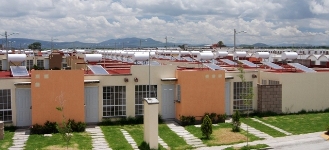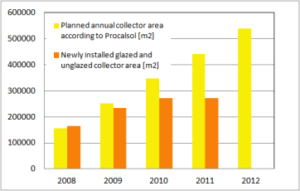Mexico: Great goals partially met
June 20, 2011
Mexico is known for its great numbers and plans which are not always fully met. Although some “great goals were only partially met”, the solar thermal market has grown substantially in recent years, mainly because of the booming building sector. The photo shows one of the newly constructed housing areas in the city of Zumpango near Mexico City, with 150 litre thermosiphon systems on each roof and a total of 1,100 systems.
Photo: GIZ / Marco Lemus
The first example of the “great goals partially met” is the national programme to Promote Solar Water Heating in Mexico (PROCALSOL), which started in 2007 and aimed at the installation of 1.8 million m2 of newly installed collector area by 2012. In the four years between 2007 and 2010, however, only 0.5 million m2 of collector area have ultimately been installed. Two years still remain to set up the other 1.3 million m2 – an unrealistic target.
The second example is the 25,000 roof programme, initiated by the German Agency for International Cooperation (GIZ). Started on 1 July 2010, the programme was thought to provide an average grant of Mexican Pesos (MXN) 1,700 (EUR 100) to 25,000 families over the next two years. According to Wiebke Mai, Solar Programme Coordinator at the GIZ office in Mexico, a total of 4,100 grants were issued in the first 11 months of the programme – which, too, has been far below expectations. Nevertheless, the programme is gaining momentum: Whereas only 1,838 applications were approved in the second half of 2010, the Mexican GIZ office counted 2,262 approved applications in the first five months of this year.
And, the third example of only partially meeting set goals can be found within the national housing programme of the current government. The government aimed at the construction of altogether 6 million houses in the current legislature between 2007 and 2012. According to the National Housing Commission, 3.3 million loans were granted in the first three and a half years until the end of 2010. It seems unlikely that the government will be able to add the remaining 2.7 million homes to the plan figure before the next parliamentary elections in July 2012, primarily because the construction sector has slowed down recently.
A report by Germany Trade and Invest from January 2011 has confirmed that the credit-based housing programme was less in demand in 2009 and 2010 than in the booming years of 2004 to 2007. The building sector decreased in 2010 for the second time in a row, by 5.3 %. Not all of the newly constructed single-family houses and flats could be sold in 2010. This created a backlog, which resulted in a declining demand for solar hot water heaters at the beginning of 2011.
More information:
http://www.gtz.de/mexico


